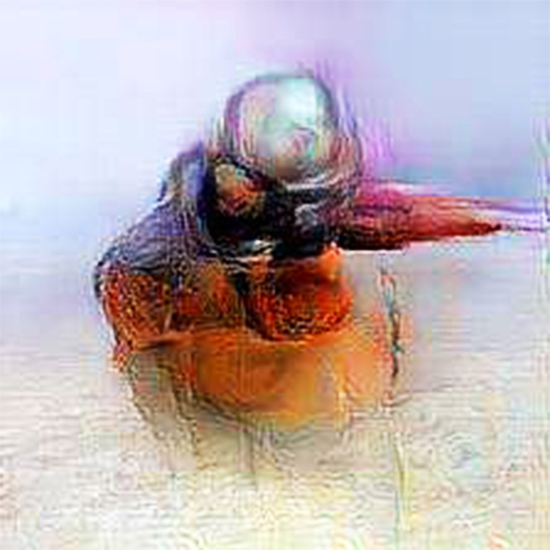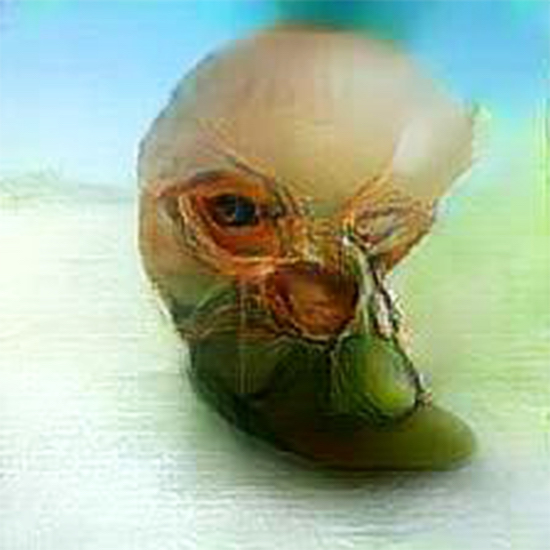Pierre Huyghe: UUmwelt, Installation view, Serpentine Gallery, London, (3 October 2018 – 10 February 2019). Copyright Ola Rindal. Courtesy of the artist and Serpentine Galleries
How! How do we see? That’s the kind of query an intelligent six-year-old might ask a parent, the simple sort of enquiry that stumps. The elder might start by patiently explaining that light hits the eye; that the rods and cones of the retina then send messages to the rear of the brain, to the occipital lobes, and then, voilà, what is out there is then both perceived and understood.
And next the kid will rightly ask – yeah, but how?
That is the question, to paraphrase Larkin, which brings the neuroscientists running over the fields. But what do they know? Pierre Huyghe co-opts a few Japanese experts in the hope that it will help us get us a few ångströms nearer the answer.
Huyghe’s show at the Serpentine (cryptically called the UUmwelt project) takes a novel squint at what Marcel Duchamp thought exhausted – retinal art. Painters like Bridget Riley still make images that appear to appeal almost exclusively to the eye and its workings, in particular that bit of cerebral matter tucked at the back of our skulls.
Duchamp wanted more; he craved art that might stretch the higher functions of the frontal lobe; something to test the ‘mind’, whatever and wherever that is. Huyghe tries to get closer to what our cortices actually do when we imagine seeing something. There are five large LED screens here and on each we try to comprehend an ever-mutating image, a vision of something that is never static, that cannot be completely resolved.

Courtesy of the artist and Serpentine Galleries; © Kamitani Lab / Kyoto University and ATR
These images are the result of studies performed by Japanese scientists from Kyoto. Subjects are told to to try and picture a named object in their heads. The team analyzes patterns of activity obtained from functional MRI brain scanning to come up with a visualization of perceptual content. How they transform this data into images is not made clear.
We are told that the data is fed through artificial intelligence into a deep neural network. Uh huh.
Basically they claim to ‘see’ what the occipital cortex is ‘seeing’ using algorithmic modeling. Ask a clinical neurologist and they will mutter sceptically. They may even call it ‘the new phrenology’. They have their doubts…
So what do the Japanese scientists and Huyghe in turn suggest the brain is up to from what we confront on these screens? And what should we take from these ever-shifting instabilities? You say to yourself – that might be a bird’s head, a chick maybe, or is it a dog? And you can get out your iPhone and freeze frame a few shots and study them later but these are of little value. The experience is all in the fluctuations of form. You look but you cannot truly see. Maybe that’s Huyghe’s gag here. This is art about how we think we see what we see that actually can’t be seen.

Courtesy of the artist and Serpentine Galleries; © Kamitani Lab / Kyoto University and ATR
The images are not particularly attractive; indeed at times they recall monstrous beings, like that piranha-faced alien that explodes out of someone’s stomach in The Thing (1982). Huyghe may want us to admire how our brains crave fixation, how life without the reality of solid forms would be frightful. But maybe he’s just playing with us. After all we still don’t really know how we see. And for an artist that must be a bit of a laugh.
As if this were not discomfiting enough Huyghe has filled the Serpentine space with flies. Yes, actual houseflies, tens of thousands of ‘em – those irritating little shits that spread diarrhoeal diseases and which most of us recoil from in acute disgust. We are informed that somehow these modify the images along with the ambient temperature and humidity in the gallery. How they do this isn’t explained and frankly I’m not sure I care; flies are foul and death to them.
Flies in art. Usually these are seen as some sort of memento mori – we think of their sly appearance in many a Dutch Master’s rendering of botanical forms to imply imminent rot. Douglas Gordon once made a sadistic video work he called Film Noir –Fly (2008) when he superglued a fly to a table, like one of Shakespeare’s little wanton bad boys, and then ran the camera as it died for sport. Damien Hirst stuck a mass of them into a vitrine with a dead cow’s head – A Thousand Years (1990) – and then had them zapped with an Insect-O-Cutor. Later he used their corpses to make ‘paintings’ by coating a canvas with the black mulch and giving them titles like, Who’s Afraid of the Dark (2002). Hugyhe goes one step further by incorporating these live pests into the show.
Outside of trying to bug us, I’m not entirely sure why he’s taken this drastic step. But let’s hazard a guess. Flies have compound eyes, that is to say each of their thousands of eyes act like external rods and cones. What they see may be something not entirely dissimilar to what we are seeing on the screens here, a mosaic image, a motion filled sequence that resists interpretation; that just is. This is how flies are so difficult to swat. They sense movement and can see over 360 degrees and get out of the way.
However the point of this show is not meant to be pedagogical. Huyghe isn’t that interested in how we see – he’s an artist not a scientist after all. Nor are his concerns primarily aesthetic – some will find the whole experience quite abhorrent. No, as an artist he’s more concerned with what we think we are seeing.
Much has been made of Hugyhe’s art in recent years. He’s very smart and clearly has a strong grasp of the freaky, the unheimlich, as with his anthropomorphic monkey in Human Mask (2014). His chaotic worlds mimic the multi-faceted world we live in with some added hip referencing to contemporary philosophy such as the object-orientated ontology of Graham Harman. UUmwelt we learn references Jakob von Uexküll’s biosemiotic ideas about the world as a particular organism experiences it.
The show then is a meditation on our different interpretations of the flux and mutability out there, our bewilderingly varied ‘truths’ of perception. Maybe this is what conceptual art about retinal art looks like. But hey, how do I know?
Pierre Huyghe, UUmwelt is at The Serpentine Gallery until 10 February 2019


